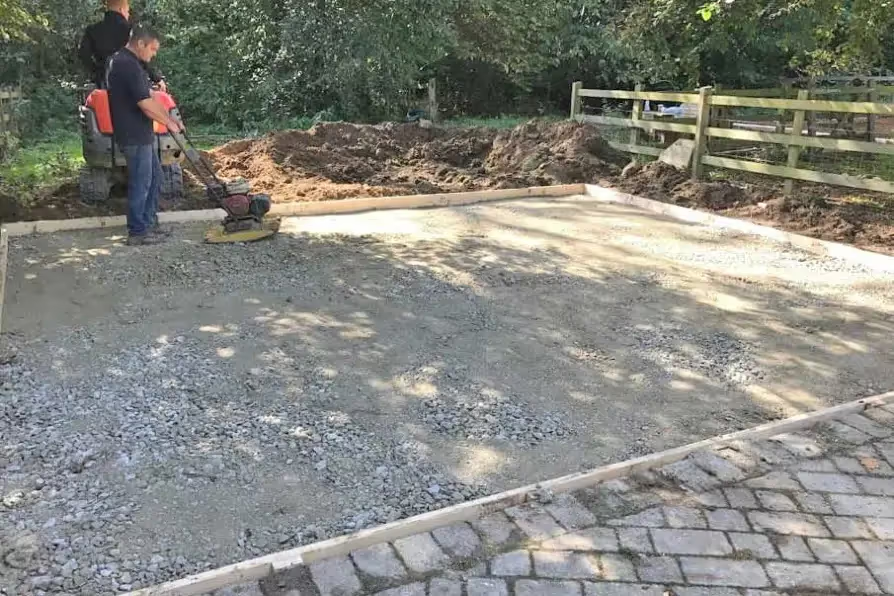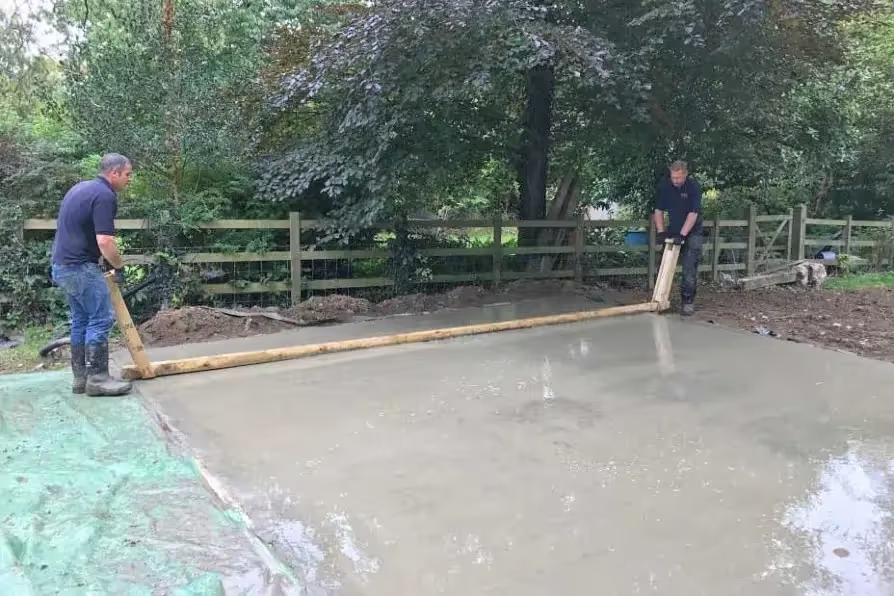
Building a timber garage requires careful planning and attention to detail, starting with the foundations. These provide a solid base to the structure, ensuring its structural integrity and durability.
In this article, we look at how to build solid wooden garage foundations, covering preparation, materials, construction techniques, and best practices.
Timber garages should be built on solid and level foundations to maintain structural integrity, as they are meant to house vehicles.
Laying a garage base prevents the building from shifting and sinking into the ground, which can lead to its collapse. The stability of a concrete base allows the structure to endure storms, strong winds, and heavy weather.
Additionally, a base lifts the building off the ground and provides a waterproof layer, preventing wood decay. This, in turn, extends the garage's lifespan.
There are only 8 steps to laying a concrete base for a garage. These need to be carefully completed following a detailed base plan, as there is no room for error.
To build a concrete base for your timber garage you will need:
It is best to invest in high-quality materials, so the concrete slab is robust and less prone to cracking.
Here are the 8 steps to laying a concrete base for a timber garage.
First, remove all vegetation and debris, including rocks and roots, from the area. Do not worry about the accuracy of the size yet, just ensure you clear an area that is bigger than the slab size indicated on the base plan.
Next, mark the area on the ground according to the dimensions on the plan. Use pegs and strings to mark all corners and edges. Make sure all corners are square by measuring the diagonals.
Then it is time to dig up the soil to create a level surface. The depth of the excavation depends on the size of the garage you are building and the weight the base will need to support. For example, if you own large, heavy vehicles, you might need to lay a thicker concrete slab.

At this stage, you should also compact the soil, using a plate compactor or a hand tamper, to create an even surface.
Next, secure timber shuttering on all sides of the perimeter of the base to create the formwork, so you can lay the concrete precisely later.
To stop the planks from bowing under the weight of the concrete, drive wooden posts into the ground around the formwork at one-metre intervals.
Once the base is secured, lay the hardcore on the soil and compact it using a manual earth rammer or a powered wacker plate.

We usually find that a 6-inch hardcore layer works well for standard-size garages. However, you should consult a contractor to establish a suitable depth for your garage.
Before pouring the concrete, lay a DPC membrane and steel mesh over the hardcore.

The DPC membrane will keep moisture out of the concrete slab, while the steel mesh will increase its stability, preventing movement and cracking. It is crucial that the mesh is raised off the hardcore and sits in the lower third of the slab's depth - otherwise, it will not be effective.
Next, prepare the concrete and pour it into the base, filling it up evenly. Use a shovel or rake to distribute it over the frame.

Once you have used up all the concrete, slide a straight-edged wooden piece across to level and tamp it down. Tamp it a second time to remove any air bubbles.
Once the concrete slab is set, lay a single brick course over it. This needs to be perfectly level, as the garage will rest directly on it.

The semi-engineering bricks ensure the concrete base stays dry by protecting it from rainwater.
The slab will take about a week to cure.
As you can see, the process is not simple and requires large tools and heavy materials. For these reasons, at Chart Garages we recommend you hire a skilled and knowledgeable contractor to lay your garage base.
When you book the installation of a timber garage with Chart Garages, we support you every step of the way. We provide clear instructions and a detailed base plan to help you prepare solid level foundations.
Below we reply to some of the most common questions about laying a concrete base for a garage.
The depth of a garage concrete slab depends on its size and the types of vehicles you will store in it. The minimum depth is 6 inches (15cm). To accommodate heavier vehicles, we recommend increasing the slab depth depending on the load up to 7.8 inches (20cm) thick.
At Chart Garages, we require you to lay steel wire mesh within the foundations to accommodate our high-quality timber garages. The mesh provides stability to the concrete, preventing it from cracking and shifting. It also helps distribute the weight of the vehicles over the slab evenly, as long as it is raised off the hardcore.
Without a wire mesh layer, the concrete slab could crack and settle. These issues can be costly to correct.
Footings are not usually required for laying a garage concrete slab. They are only necessary for garages built on sloping ground or poor condition soil.
A 4-inch garage concrete slab does not require rebar. However, we recommend laying wire mesh before pouring concrete over the compacted hardcore, as it provides prevents cracking.


